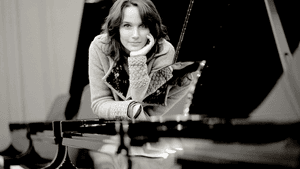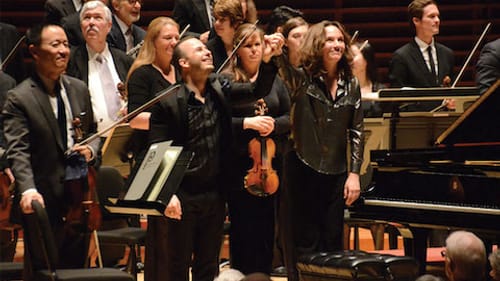Stay in the Loop
BSR publishes on a weekly schedule, with an email newsletter every Wednesday and Thursday morning. There’s no paywall, and subscribing is always free.
Beethoven and the BFFs
Philadelphia Orchestra presents 'Yannick and Hélène'

Ah, the wonders of classical music. Take Hélène Grimaud’s reading of Beethoven’s Piano Concerto No. 4 in G major, with the Philadelphia Orchestra. Not only is it an uncontested staple of the repertoire, it’s also my favorite piano concerto. And just when you think you’ve heard every possible interpretation of a masterpiece, along comes someone new and exciting who turns your preconceptions upside down and transforms the work in ways you couldn’t imagine.
Much has been written about Grimaud’s close artistic friendship with Yannick Nézet-Séguin. All I can say is, if friendships produce this kind of artistry and insight, let’s start pairing up great musicians and conductors now.
Like a ninja
The Beethoven was the centerpiece of the orchestra’s sold-out final concert in Philadelphia this season. The company embarks on a tour (with Grimaud and other soloists) of Europe and Israel this week.
After a kinetic performance of Dvořák’s Othello Overture, the orchestra was joined by Grimaud with Nézet-Séguin at the podium. Their electricity was evident even as they crossed the stage together, crackling throughout an incandescent performance that never once flickered.
Grimaud, of course, was the star of this production. From the first measures, the pianist has the unenviable task of beginning the concerto with a stark but commanding solo entrance in a passage more about rhythm than melody. Those quiet, tentative few measures create a foundation on which the concerto is built: if not articulated smartly, the entire work may collapse.
But Grimaud, wearing an unadorned black top and slacks, sprang into action. With ninja stealth, she established context and originated, from the very first notes, her unique perspective. This may be a work from Beethoven’s middle, or “heroic,” period, but Grimaud wisely perceives there is no need to clobber the keys to get the point across.
Her sure but graceful touch brings lyricism to every passage of the three movements, conveying strength when needed but also eliciting complexities and nuances comparable to some of the finest writing of the last piano sonatas.
I wondered how I could have listened to this work so many times and missed an entire layer of meaning. Its sometimes relentless musical lines twist and turn like roots of ancient trees, and you don’t know they’re there until a savvy trailmaster points them out. The wilderness metaphor may be no accident, since, in her private life, Grimaud is a conservationist and protector of wolves.
Of course, it is Beethoven, so there are moments of whimsical prancing as well as thunder in the lower register. But it all evens out in a performance that cleanly matches Nézet-Séguin’s intensity with Grimaud’s delight in discovery and her distinctive intelligence and love of beauty. Grimaud’s interpretation of the cadenza was extraordinary, not just for its technical virtuosity but for her exploration of Beethoven’s thought process.

The "Gloriette"
The program concluded with another Beethoven masterpiece: the Symphony No. 7 in A major. We sometimes think of the Ninth only as the “Ode to Joy,” but Beethoven’s whole life was an ode to joy, and this work in particular deserves the moniker.
Given his life in the late 18th and early 19th centuries, there wasn’t a lot to be joyful about: the Reign of Terror, Napoleon, the eruption of Mount Tambora, the Year without a Summer, a suicide epidemic among young Romantics, his failure to find love, his deafness.
Yet he celebrated hope, nature, and the human spirit at every turn. We hear this especially in the Seventh Symphony, with three bacchanalian movements wrapped around an Allegretto that may not have an equal in Western music. Nicknames abound for Beethoven’s works; why is there no nickname for this irresistible earworm?
I propose calling it the “Gloriette,” named for a dreamy architectural fantasy at Vienna’s Schönbrunn Palace. Beethoven often sat outside there on the low branch of a big old tree, jotting down musical ideas.
Nézet-Séguin threw everything he had into the performance and conducted with just the right balance of youthful fire and regard for structural integrity. Both conductor and orchestra seemed to enjoy one of the composer’s pranks about three and a half minutes into the first movement: a series of sly little notes and exaggerated rests just before the shift to 6/8 time.
I demurred only at the rapid progression from movement one to movement two, since the haunting second movement creates such a different mood from the jubilation of the first. However, the spritely shift from movement three to movement four worked well, as the ebullience of the last movement springs directly from the third.
Wagner called this work the apotheosis of the dance, but I call it pure Dionysus, the ecstasy of great art in communion with open minds and hearts.
What, When, Where
Yannick and Hélène. Hélène Grimaud, piano; Yannick Nézet-Séguin, conductor. The Philadelphia Orchestra. Beethoven, Piano Concerto No. 4 in G major, Op. 58; Beethoven, Symphony No. 7 in A major, Op. 92; Dvořák, Othello, concert overture, Op. 93. May 17 and 20, at the Kimmel Center's Verizon Hall, 300 S. Broad Street, Philadelphia. (215) 893-1999 or philorch.org.
Sign up for our newsletter
All of the week's new articles, all in one place. Sign up for the free weekly BSR newsletters, and don't miss a conversation.
 Linda Holt
Linda Holt